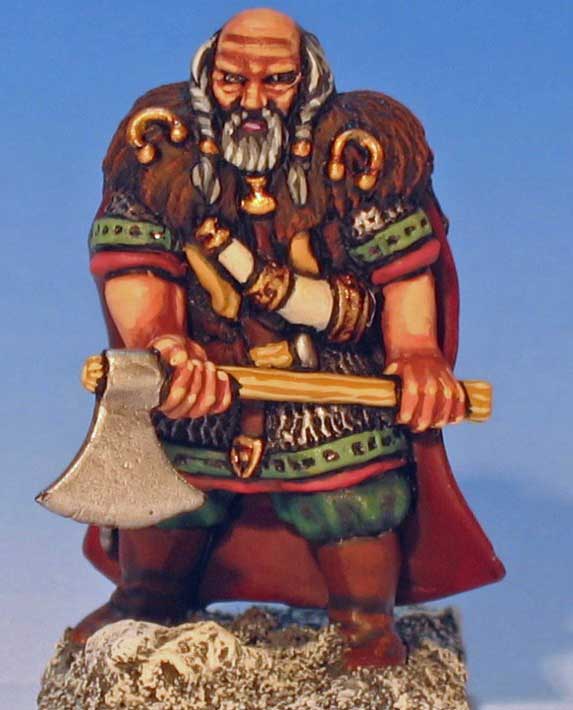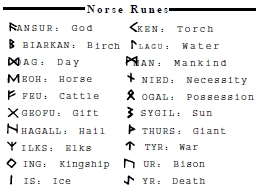

Eli Magic-User
ALIGNMENT: Chaotic Neutral
HIT POINTS: 83
ARMOR CLASS: 2
NO. OF ATTACKS: 2/1
DAMAGE/ATTACK 1-8(+5)
SPECIAL ATTACK: See below
HIT BONUS: +3
MOVE: 8Ē
PSIONIC ABILITY: Nil
STRENGTH: 18/79
INTELLIGENCE: 17
WISDOM: 11
DEXTERITY: 13
CONSTITUTION: -1 18/05
CHARISMA: 9
There was a man Ulf Bjalfason. His mother
was Hallbera, daughter
of Ulf Uarge (Ulf the Fearless), and the
sister of Hallbjom Sea-Troll. Ulf
Bjalfason married Salbjorg, Kariís daughter.
They had two sons,
named Thorolf and Grim.
Ulf Bjalfason was a hard worker, a skilled
craftsman, and an expert
advisor. Unfortunately, as evening approached,
he always grew so
ill-tempered that no one could speak to
him. He often disappeared at
night. People began calling him Kveld-Ulf
(Evening Wolf) and believed
that he was a werewolf shapechanger.
About this time, Halfdan the Blackís son,
Harald, became King of
East Oslofjord. He swore an oath never
to cut his hair until all Norway
was under his rule. For this reason he
was known as Harald the
Shaggy or Harald Fairhair. When Haraldís
messengers reached Fjord
Province, demanding fealty to the new
King of Norway, Kveldulf
defied the king personally, but compromised
by sending his son
Thorolf to serve Harald Fairhair.
Thorolf served the king well, being awarded
the trading rights to
Finnmark. Trade included ďtax-gathering,Ē
a legal form of plunder to
be split with the king. Thorolf was so
successful that he incurred the
jealousy of the Hildiridarsons, a powerful
family allied to King Harald.
The Hildiridarsons began to spread slander
about Thorold which
the king eventually believed. Harald Fairhair
surrounded Thorolfís
stead with his men, burnt the meadhall,
and killed Thorolf when he
tried to break out of the burning building.
Kveldulf and Grim took their
revenge by killing Sigurd and Ragnar,
the son of Guttorm, King
Haraldís uncle and foster father. After
that deed, they had little choice
but to flee to Iceland with all their
goods and families.
By the time Grim was in his twenties, he
was already bald, thus
gaining the name Skallagrim (Bald-Grim).
Skallagrim was a great
blacksmith who, in battle, often lost
control, fighting as a berserker.
Skallagrim and his wife Bera had two sons,
Thorolf and Egil. Egil
grew to be nearly seven feet tall, muscular,
black-haired, and ugly as
his father. When Egil was only six, he
killed a boy nearly twice his age.
At age twelve, Egil was nearly killed
by his father, who was in a berserk
rage over one of Egilís deeds.
Thorold Skallagrimson, on a trading expedition
in Norway,
chanced upon Eirik, son of Harald Fairhair.
The two men exchanged
gifts in an attempt to end the blood feud
between the two families.
Eirik eventually came into the kingship
of Norway. By this time he had
earned the name Eirik Bloodaxe.
Thorolf and Egil journeyed to Norway to
see King Eirik. One night
they stopped at Atley Island, one of the
kingís estates, run by a man
named Bard. Contrary to the unwritten
laws of hospitality, Bard put
them up in an outbuilding and served them
stale food with sour curds
to drink, saying he wished he could serve
them better but the good
food and ale was all gone.
That same evening, King Eirik arrived.
Bard threw a banquet in the
Main Hall, serving the good food and ale
he had been too cheap to
serve Egil and Thorolf. Egil joined the
banquet. Though only 17, he
was an accomplished poet. He drank a toast
each time he drained a
horn of ale. Each toast was an impromptu
poem satirizing Bardís
hospitality. Egilís thirst seemed endless.
Eventually, to silence him,
Bard slipped poison into Egilís drinking
horn (with the permission of
Eirikís queen, Gunnhild). Egil stabbed
his own palm and carved
bloody runes
on the hornó which burst asunder, spewing poisoned
ale all over the straw-covered floor.
Egil stormed out of the hall. When Bard
followed, Egil drew his
sword and slew the man. King Eirik raged
against Egil, but eventually
accepted a payment of weregild in compensation
for Bardís death,
providing Egil left the country and did
not return.
Egil and Thorolf now roved through the
Baltic as Vikings, taking
much plunder.
One year, Egil wintered in Norway with
friends, King Eirik heard of
this only after the fact. Later that same
year, Queen Gunnhildís
brother, Eyvind Shabby, laid a trap for
Egil off the coast of Jutland.
Egil learned of the trap and turned the
tables on Eyvind, killing him
and all his crew. The blood feud between
the Yngling kings of Norway
and the Ulfsons was back in full force.
Egil is not only contemptuous of Eirikís
power, but of authority in
general, and kings in particular. He looks
out only for himself. While
Egil is not actively evil, his quick temper
usually spoils any good
actions he may make. Egil is proud of
his prowess as a poet, particularly
as an impromptu poet. He may well challenge
the party to a
poetry match. Egil expects lavish hospitality
and will act sarcastically
when in the company of individuals whom
he considers cheap, cowardly
or overbearingly authoritative. He is
not averse to using his
magic to gain his own ends.
In a normal battle, there is a 50% chance
that Egil will tear off his
armor and throw away his shield to fight
as a berserker. Each berserk
hit does double damage, while his armor
class drops to 8 (his leather
gambeson). If he is insulted, particularly
if his poetry is involved, Egilís
chances to go berserk rise to 90%. While
in a berserk fury, there is
only 25% chance that Egil will be thinking
clearly enough to use his
magic.
Egil wears Chain Mail +1, with a wooden
Shield +1. He fights
with a Sword + 1. He carries a Periapt
of Proof Against Poison +4.
SPELLS
| 1st | Burning Hands (Ken: Torch)* | Charm Person (Ogal: Possession) | Light (Ken: Torch) | Read Magic (Ansur: God) | Magic Missile (Tyr: War) |
| 2nd | Strength (Thurs: Giant) | Locate Object (Geofu: Gift) | Continual Light (Ken: Torch) | Darkness 15í R (Sygil: Sun) | Knock (Nied: Necessity) |
| 3rd | Feign Death (Yr: Death) | Fireball (Sygil: Sun) | Water Breathing (Lagu: Water) | Suggestion (Nied: Necessity) | Fire Arrow (Ken: Torch) |
| 4th | Charm Monster
(Ogal: Possession) |
Ice Storm (Hagall: Hail) | Fear (Tyr: War) | Plant Growth (Biarkan: Birch) | - |
| 5th | Airy Water (Lagu: Water) | Animal Growth (Eoh: Horse) | Cloudkill (Yr: Death) | Cone of Cold (Is: Ice) | - |
| 6th | Control Weather (Dag: Day) | **Tenserís Transformation
(Tyr: War) |
- | - | - |
| 7th | Charm Plants (Ogal: Possession) | - | - | - | - |
* In parentheses is the name of the Norse
rune which powers the
spell and an approximate English translation
of the runic name. The
runes are illustrated in the accompanying
chart. For those who seek
additional authenticity in the game, carving
the rune of wood or
drawing it on parchment should be considered
an alternative or
additional somatic (S) component of the
spell. Runes may be already
carried or carven on the spot.
**DMís note: this spell should be used
guardedly in conjunction
with Egilís berserk Fury rule, as together
they may make Egil too
powerful for the party. Though this spell
does fit Egilís personality, an
alternative spell such as Death (Yr: Death)
or Reincarnation (Rad:
Wheel), may be substituted, or the DM
may disallow Tenserís Transformation
and simultaneous berserking.
SOURCE: Egilís Saga, translated by Hermann
Palsson and Paul
Edwards (paperback, Penguin Books).

by Tom Moldvay
| Giants in the Earth | - | - | - | Dragon 39 |